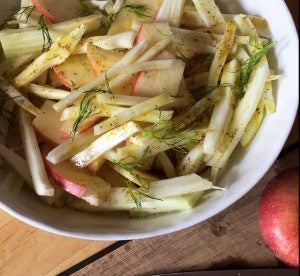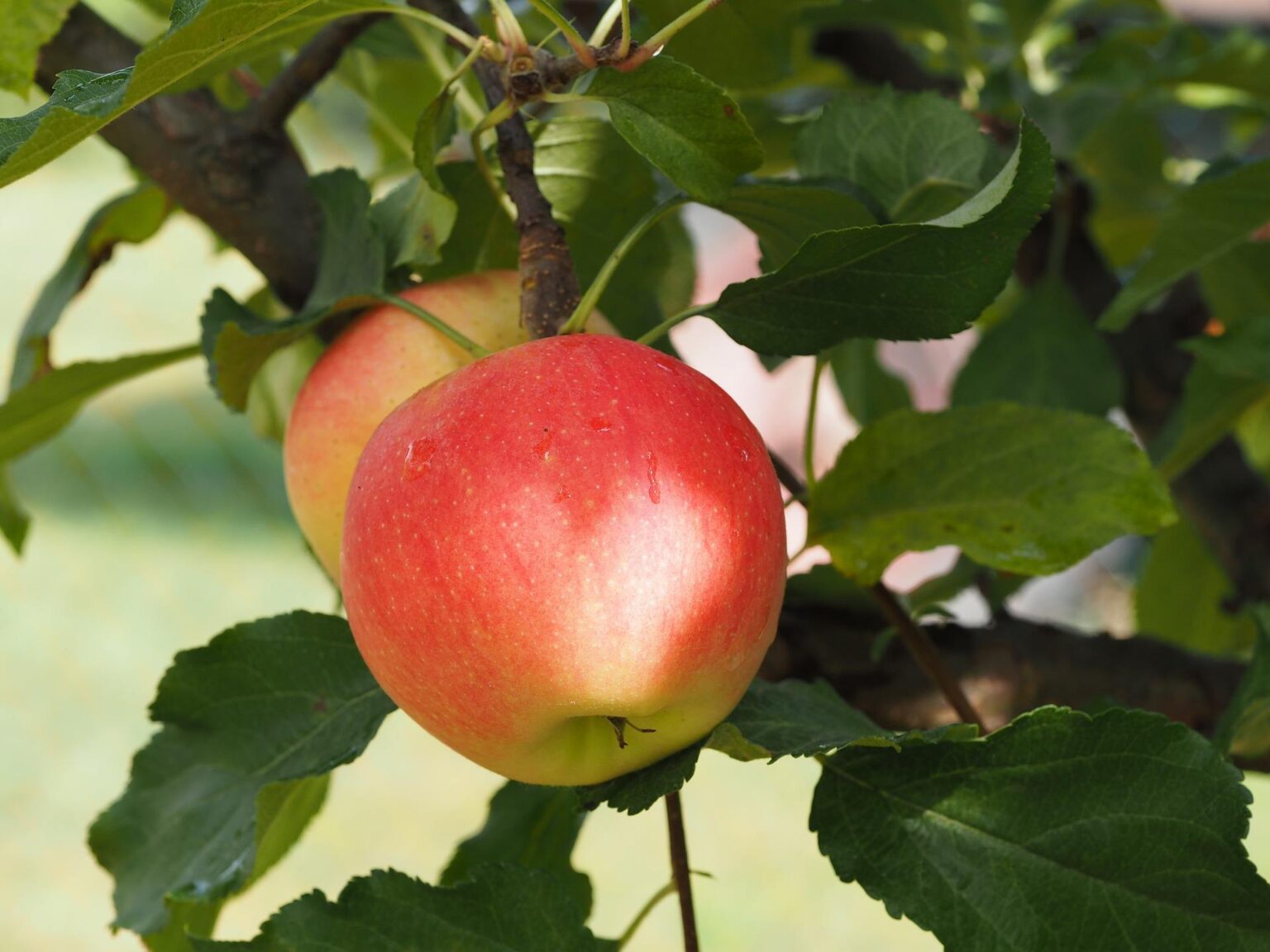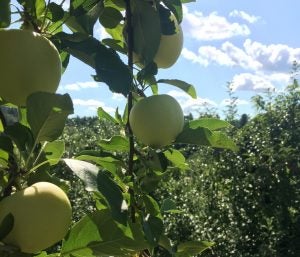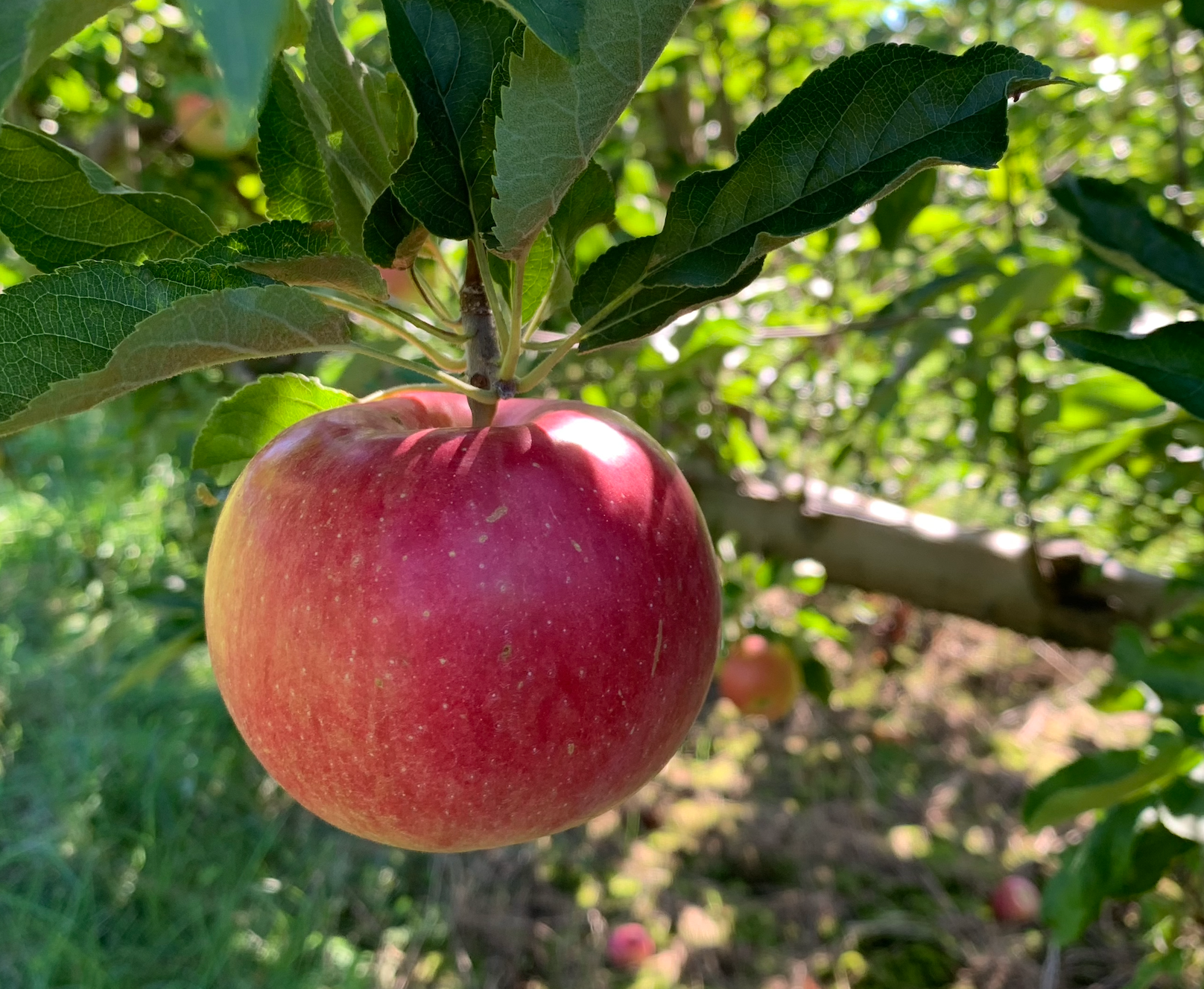
Does eating an apple every day really keep the doctor away? Apples are certainly popular—ranking among the top three fruits produced around the world. They are easy to store and transport, and as a result, are typically available year-round in the U.S. In this piece we’ll explore how apples may benefit health and the best types for baking versus munching straight off the core.
Source Of
Fiber, insoluble and soluble
Phytochemicals (quercetin, catechin, chlorogenic acid, anthocyanin)
Vitamin C
One serving, or one medium apple, provides about 95 calories, 0 gram fat, 1 gram protein, 25 grams carbohydrate, 19 grams sugar (naturally occurring), and 3 grams fiber.
Apples and Health
Apples are rich in quercetin and pectin, both of which are credited for supplying apples with their health benefits. [1] Quercetin is a flavonoid, a type of naturally occurring plant chemical that has antioxidant and anti-inflammatory effects. Pectin is a type of soluble fiber that may help prevent constipation and have a modest effect on lowering LDL, the “bad” cholesterol. Pectin is also fermented by beneficial bacteria in the colon, which produces short chain fatty acids that may play a role in the prevention of chronic diseases, including certain cancers and bowel disorders. [2,3]
Fresh, whole apples offer the most nutrients. Discarding the skin removes much of the fiber and the majority of flavonoids. Dehydrating or drying the apples removes vitamin C, which is predominantly in the flesh. In addition, sugar (along with extra calories) is often added to dried apples. Clear apple juice undergoes filtering and pasteurization, which removes most of the flavonoids and fibers. [3]
Overall research shows a benefit when adding apples to the diet. The studies below looked at the health effects of apples in the diet over time, or examined the effects of specific phytochemicals in apples.
Cardiovascular disease
Animal studies have shown that plant chemicals, particularly in the apple peel, combined with pectin fiber can help to protect against free radical damage in the heart and blood vessels and have cholesterol-lowering effects. [3,4] Human intervention studies using fresh apples, apple cider, or apple supplements show mixed results, showing no effect or other times lowering cholesterol. [3] A review of five clinical trials noted the effects of fruits on cardiovascular diseases, and found an improvement in cardiovascular parameters (decreased triglycerides and LDL cholesterol) with intakes of whole fresh apples or dried apples, though not with apple juice. [4]
Population studies on coronary heart disease and flavonoid intake, including quercetin from apples, also show mixed results:
A study of more than 66,000 women from the Nurses’ Health Study found that, when comparing the highest and lowest intakes of flavonoids, there was no difference in rates of heart attack or deaths from heart disease. [5]
A cohort study following almost 75,000 Swedish men and women for 10 years found a significant association: lower risk of stroke was seen in the group with the highest intakes of apples compared with the lowest intakes. [6]
Type 2 diabetes
The antioxidant effect of flavonoids in apples may protect cells from damage in the pancreas, an organ responsible for secreting insulin in response to extra sugar in the blood. An epidemiological study of more than 38,000 women in the Women’s Health Study followed for almost nine years supported a beneficial relation between apple intake and risk of type 2 diabetes. Those who ate one or more apples a day had a 28% lower risk of type 2 diabetes compared with those who ate none. Although the study established a link with apples in the diet, it did not show an association when examining specific flavonoids like quercetin. [7]
Weight management
The fibers in apples can slow digestion, helping one to feel greater satisfaction after eating. After following three large prospective cohorts of 133,468 men and women for 24 years, researchers found that higher intakes of fiber-rich fruits with a low glycemic load, particularly apples and pears, were associated with the least amount of weight gain over time. Eating low glycemic load foods tends to produce fewer and smaller spikes in blood sugar, which may lessen hunger later on and prevent overeating. [8]
Cancer
The phytochemicals and fiber in apples have antioxidant effects that may protect a cell’s DNA from oxidative damage, which is a precursor to cancer. Animal and cell studies have found that these chemicals can prevent new cancer cells from growing and the spread of existing cancer cells. Results from human studies are mixed, depending on the type of study performed.
Specific cancers: Evidence suggests that a decreased risk of lung cancer with higher intakes of all fruits (including apples) applies mainly to smokers and former smokers. [9,10] In a meta-analysis of 41 case-control and cohort studies found that when comparing the highest with lowest levels of apple intake, there was a lower risk of lung cancer in both types of studies. It also found a lower risk of colorectal, breast, and digestive tract cancers in the case-control studies but not cohort studies. [11] Other epidemiological studies have shown a small association of higher intakes of fruit and a lower risk of colon and upper digestive tract cancers (e.g., esophageal, mouth, larynx). [10]
Apples continuously top the list of fruits highest in pesticide residues. They often require more pesticides as they are particularly susceptible to bugs and disease. Although apples are generally washed before being sold, the amount of remaining residue is unknown and may vary widely (partly depending on the type and amount of pesticide applied).
However, the U.S. Department of Agriculture and the Environmental Protection Agency (EPA) have developed a national pesticide residue database called the Pesticide Data Program (PDP) to collect data each year on pesticide residues in food. One of the most common pesticides used on apples after harvest is diphenylamine, used to prevent apple scald or browning of the skin that can occur during storage. A 2016 analysis from the PDP found that 80% of 531 apple samples contained residues of this chemical at 0.002-3.8 ppm, which is below the EPA’s tolerance level of 10 ppm. [12] A tolerance level is the maximum amount of residue allowed on a raw food. This amount is based on a review of numerous scientific studies to determine possible harmful effects the chemical could have on humans, the amount of residue likely to remain in or on the food, and the amount of the food that people typically eat.
Although some pesticide residue can permeate into the flesh, washing and peeling the apple skin removes much of the pesticide. Apple skin supplies the majority of healthy phytochemicals and fiber, so it is not best to remove it. If one eats several apples a week and is unsure of the amount of pesticides used, purchasing organically grown apples may be an option, although direct evidence is not available that there is an important difference in health effects.
Some general tips for cleaning apples:
The Food and Drug Administration recommends washing all produce thoroughly (including organic) under running water before preparing or eating. Firm produce like apples may be scrubbed with a clean produce brush. They do not recommend washing produce with soap, detergent, or even commercial produce washes. The washes are intended for killing bacteria rather than removing pesticides, and studies have shown that water is just as, if not more, effective than produce washes for removing bacteria. [13]
Baking soda is effective at removing bacteria and breaking down pesticide residues so they are more easily rinsed off, but this method requires a few extra steps. Soak the apple in a baking soda solution of 1 teaspoon of baking soda and 2 cups water for 10-15 minutes, then rinse well. To save time, soak a large batch of apples, rinse well, and then dry each thoroughly with a towel before storing in the refrigerator (as any remaining excess moisture can promote mold or spoilage).
Keep in mind that the health benefits of eating fruits and vegetables outweigh potential pesticide risks, and should not deter one from including apples as part of a healthful diet.
Storage

If stored at room temperature, the enzymes and ethylene gas in apples quicken ripening. They will last on your counter for about 1-2 weeks but the texture can change during this time.
Serve
There are at least a dozen types of apples found in U.S. supermarkets, but up to 100 varieties are available. Check out local farms and farmers markets for more unusual heirloom varieties. Some are best for cooking and baking, and others are enjoyed raw for snacking. They range from sweet to tart, and may produce a hearty crunch or a light crispy bite.
Tart, mildly sweet apples with firm crisp flesh that don’t become mushy at high temperatures are best for baking: Jonagolds, Granny Smith, Honeycrisp, Melrose, Cortland, Braeburn.
Juicy and sweet flavors are often chosen for eating: Gala, Red and Golden Delicious, Fuji, McIntosh. If you prefer tart over sweet, baking apples can certainly be eaten as well!
Some fun ways to enjoy apples:
Cut one apple into thin slices and spread with nut or seed butter.
Enjoy a sweet/salty, crunchy/creamy combo by pairing apple slices with thin slices of cheddar cheese.
Apple sandwich: Remove the center and seeds of an apple with a corer and slice the apple into rounds about a ½-inch thick. Spread one apple slice with nut or seed butter and sprinkle with granola or trail mix. Then place another apple slice on top.
Oven-baked apple chips: Core apple and slice very thinly or with a mandoline. Place on a lightly greased baking sheet or parchment paper. Sprinkle with cinnamon. Bake at 225 degrees F for one hour (higher temperatures can burn the apples). Flip apple slices and bake for up to 1 hour more or until apple chips feel dry. Transfer to a cooling rack and let cool completely.
Waldorf salad: Chop 2 large apples into small chunks and add to large bowl with ½ cup walnuts, 1 sliced celery rib, and ¼ cup raisins. Sprinkle with lemon juice. Prepare the dressing by combining ½ cup nonfat plain yogurt, 1-2 tablespoons mayonnaise, teaspoon of lemon zest, and pinch of pepper. Fold dressing into apple mixture and stir well.

More recipes featuring apples:
Did You Know?
Apple juice and apple cider are different!
Cider is produced when raw apples are mashed and pressed to extract the liquid. It is not filtered and sold either pasteurized or unpasteurized. This causes cider to appear cloudy, as it contains pulp and sediment. It is more acidic and contains more flavonoids than apple juice.
Apple juice has been filtered to remove solids and pasteurized so that it remains fresher longer. Sugar is sometimes added. During filtration, the tart and bitter flavors from the natural apple flavonoids may be removed, so apple juice typically has a uniform sweet flavor.
Apples are among the oldest and most recognizable fruits in the world. But have you ever really considered an apple’s shape? Using theory and experiments, researchers at the Harvard John A. Paulson School of Engineering and Applied Sciences show how apples get their distinct spherical shape, and the characteristic dimple at the top where the stem grows.
Read more
References
Wojdyło A, Oszmiański J, Laskowski P. Polyphenolic compounds and antioxidant activity of new and old apple varieties. Journal of Agricultural and Food Chemistry. 2008 Jul 9;56(15):6520-30.
Gerhauser C. Cancer chemopreventive potential of apples, apple juice, and apple components. Planta medica. 2008 Oct;74(13):1608-24.
Koutsos A, Tuohy KM, Lovegrove JA. Apples and cardiovascular health—is the gut microbiota a core consideration?. Nutrients. 2015 May 26;7(6):3959-98.
Zhao CN, Meng X, Li Y, Li S, Liu Q, Tang GY, Li HB. Fruits for prevention and treatment of cardiovascular diseases. Nutrients. 2017 Jun 13;9(6):598.
Lin J, Rexrode KM, Hu F, Albert CM, Chae CU, Rimm EB, Stampfer MJ, Manson JE. Dietary intakes of flavonols and flavones and coronary heart disease in US women. American journal of epidemiology. 2007 Mar 22;165(11):1305-13.
Larsson SC, Virtamo J, Wolk A. Total and specific fruit and vegetable consumption and risk of stroke: a prospective study. Atherosclerosis. 2013 Mar 1;227(1):147-52.
Song Y, Manson JE, Buring JE, Sesso HD, Liu S. Associations of dietary flavonoids with risk of type 2 diabetes, and markers of insulin resistance and systemic inflammation in women: a prospective study and cross-sectional analysis. Journal of the American College of Nutrition. 2005 Oct 1;24(5):376-84.
Bertoia ML, Mukamal KJ, Cahill LE, Hou T, Ludwig DS, Mozaffarian D, Willett WC, Hu FB, Rimm EB. Changes in intake of fruits and vegetables and weight change in United States men and women followed for up to 24 years: analysis from three prospective cohort studies. PLoS medicine. 2015 Sep 22;12(9):e1001878.
American Institute for Cancer Research. Diet, nutrition, physical activity and lung cancer. Revised 2018. http://www.aicr.org/continuous-update-project/reports/lung-cancer-2018.pdf. Accessed 9/17/18.
Bradbury KE, Appleby PN, Key TJ. Fruit, vegetable, and fiber intake in relation to cancer risk: findings from the European Prospective Investigation into Cancer and Nutrition (EPIC)–. The American journal of clinical nutrition. 2014 Jun 11;100(suppl_1):394S-8S.
Fabiani R, Minelli L, Rosignoli P. Apple intake and cancer risk: a systematic review and meta-analysis of observational studies. Public health nutrition. 2016 Oct;19(14):2603-17.
USDA Pesticide Data Program. Annual Summary, Calendar Year 2016. https://www.ams.usda.gov/sites/default/files/media/2016PDPAnnualSummary.pdf.pdf. Accessed 9/27/18.
Produce: Selecting and Serving it Safely. https://www.fda.gov/Food/ResourcesForYou/Consumers/ucm114299.htm. Accessed 9/27/18.
Terms of Use
The contents of this website are for educational purposes and are not intended to offer personal medical advice. You should seek the advice of your physician or other qualified health provider with any questions you may have regarding a medical condition. Never disregard professional medical advice or delay in seeking it because of something you have read on this website. The Nutrition Source does not recommend or endorse any products.



